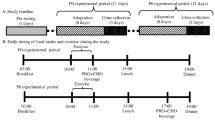Abstract
This study compared protein turnover in ten young female gymnasts [10.3 (0.5) years] engaged in regular intense physical training with ten age-matched controls [9.4 (0.6) years)]. Nitrogen flux ( Q), protein synthesis (PS), protein degradation (PD) and net protein turnover (NPB = PS−PD) were measured following a single oral dose of [15N]-glycine. The habitual dietary intake of each subject was assessed using a 7-day food record, with food portions being weighed before ingestion. The gymnasts had a low total energy intake which was unbalanced in the proportions of lipid, carbohydrate and protein. Protein flux was 7.19 (0.35) g.kg−1.day−1 in the gymnasts and 7.53 (0.81) g.kg−1.day−1 in the controls; protein synthesis was 6.06 (0.27) g.kg−1.day−1 in the gymnasts and 6.53 (0.74) g.kg−1.day−1 in the controls; protein degradation was 5.45 (0.38) g.kg−1.day−1 in the gymnasts and 5.27 (0.74) g.kg−1.day−1 in the controls. All data are presented as means and standard errors of the mean (SEM). There were no statistical differences for protein flux, protein synthesis or protein degradation between the two groups. However, NPB was lower (−14%) in the trained gymnasts than in the control group ( P <0.05), which might be explained by a greater protein ingestion in the control group on the day of the protocol ( P <0.05). These results show that in pre- and early pubertal female gymnasts intense training does not exert a demonstrable effect on protein turnover.

Similar content being viewed by others
References
ANC (2001) Nutritional recommended intakes for the French population. Tec et Doc Lavoisier, Paris
Arslanian SA, Kalhan SC (1996) Protein turnover during puberty in normal children. Am J Physiol 270:E79–E84
Beckett PR, Jahoor F, Copeland KC (1997) The efficiency of dietary protein utilization is increased during puberty. J Clin Endocrinol Metab 82:2445–2449
Boisseau N, Delamarche P (2000) Metabolic and hormonal responses to exercise in children and adolescents. Sport Med 30:405–422
Boisseau N, Le Creff C, Loyens MP, Poortmans JR (2002) Protein intake and nitrogen balance in male non-active adolescents and soccer players. Eur J Appl Physiol 88:288–293
Bolster DR, Pikosky MA, McCarthy LM, Rodriguez NR (2001) Exercise affects protein utilization in healthy children. J Nutr 131:2659–2663
Costill DL, Sherman WM, Fink WJ, Maresh C, Witten M, Miller JM (1981) The role of dietary carbohydrate in muscle glycogen resynthesis after strenuous running. Am J Clin Nutr 34:1831–1836
Cupisti A, D’Alessandro S, Castrogiovanni S, Barale E, Morelli E (2000) Nutrition survey in elite rhythmic gymnasts. J Sports Med Phys Fitness 40:350–355
Dietary Reference Intakes (2002) Energy, carbohydrate, fiber, fat, fatty acids, cholesterol, protein, and amino acids. Institute of Medicine, Washington
Ebbeling CA, Rodriguez NR (1999) Effects of exercise combined with diet therapy on protein utilization in obese children. Med Sci Sports Exerc 31:378–385
Fern EB, Garlick PJ, Waterlow JC (1985) Apparent compartmentation of body nitrogen in one human subject: its consequences in measuring the rate of whole-body protein synthesis with 15N. Clin Sci (Lond) 68:271–282
Fogelholm GM, Kukkonen-Harjula TK, Taipale SA, Sievänen HT, Oja P, Vuori IM (1995) Resting metabolic rate and energy intake in female gymnasts, figure-skaters and soccer players. Int J Sports Med 16:551–556
Jackson AA, Picou D, Landman J (1984) The non-invasive measurement of urea kinetics in normal man by a constant infusion of [15N]-urea. Hum Nutr Clin Nutr 38:339–354
Jackson AA, Duggleby SL, Grove G (2000) Whole body protein turnover can be measured non-invasively in women using the end product method with [15N]-glycine to show changes with the menstrual cycle pregnancy. Eur J Clin Nutr 54:329–336
Jonnalagadda SS, Bernardot D, Nelson M (1998) Energy and nutrient intakes of the United States national women’s artistic gymnastics team. Int J Sport Nutr 8:331–344
McKenzie S, Phillips, SM, Carter SL, Lowther S, Gibala MJ, Tarnopolsky MA (2000) Endurance exercise training attenuates leucine oxidation and BCOAH activation during exercise in humans. Am J Physiol 278:E580–E587
Pariskova J (1961) Total body fat and skinfold thickness in children. Metabolism 10:794–807
Phillips SM (2002) Assessment of protein status in athletes. In: Driskell JA, Wolinsky I (eds) Nutritional assessment of athletes. CRC, Washington, pp 283–316
Pikosky M, Faigenbaum A, Westcott W, Rodriguez N (2002) Effects of resistance training on protein utilization in healthy children. Med Sci Sports Exerc 34:820–827
Poortmans JR (2004) Protein metabolism. In: Poortmans JR (ed) Principles of exercise biochemistry, 3rd revised edn. Medicine and Sports Science, vol 46. Karger, Basel, pp 227–278
Probart CK, Bird PJ, Parker KA (1993) Diet and athletic performance. Clin Nutr 77:757–772
RDA (1989) Commission on Life Sciences recommended daily allowances, 10th edn. National Academy, Washington DC
Rogol AD, Clark PA, Roemmich JN (1990) Growth development in children and adolescents: effects of diet and physical activity. Am J Nutr 72 [Suppl]:521S–528S
Stroud MA, Jackson AA, Waterlow JC (1996) Protein turnover rates of two human subjects during an unassisted crossing of Antarctica. Br J Nutr 76:165–174
Su-Vi-Max (1994) Slides with food portions. Polytechnica, Paris
Torun B, Davies PSW, Livingstone MBE, Paolisso MR, Sackett R, Spurr GB (1996) Energy requirements and dietary energy recommendations for children and adolescents 1 to 18yrs old. Eur J Clin Nutr 50 [Suppl]:S37–S81
Waterlow JC, Golden MHN, Garlick P (1978) Protein turnover in man measured with 15N: comparison of end products and dose regimes. Am J Physiol 235:E165–E174
Weimann E, Witzel C, Schwidergall S, Böhles H (1999) Peripubertal perturbations in elite gymnasts caused by sport specific training regimes and inadequate nutrition intake. Int J Sports Med 21:210–215
Acknowledgements
The authors would like to thank the children and their parents for their co-operation and hard work throughout the study. In addition, we would like to thank M. Vermorel and P. Patureau Mirand (INRA, Clermond-Ferrand) for their specific suggestions in preparing the present manuscript and Mrs F. Reding (ULB, Brussels) for her skilful technical assistance.
Author information
Authors and Affiliations
Corresponding author
Rights and permissions
About this article
Cite this article
Boisseau, N., Persaud, C., Jackson, A.A. et al. Training does not affect protein turnover in pre- and early pubertal female gymnasts. Eur J Appl Physiol 94, 262–267 (2005). https://doi.org/10.1007/s00421-004-1264-5
Accepted:
Published:
Issue Date:
DOI: https://doi.org/10.1007/s00421-004-1264-5




